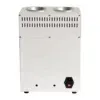 English
English


Understanding the Importance and Procedure of High Potential Electrical Testing in Safety Compliance
The Importance of Hi-Pot Electrical Testing
Hi-Pot testing, short for High-Potential testing, is a critical procedure used in the electrical manufacturing industry to ensure the safety and reliability of electrical devices and equipment. This testing method involves applying a high-voltage potential between the electrical components and the ground, which helps to identify any dielectric weaknesses or insulation failures. By integrating Hi-Pot testing into the quality control processes, manufacturers can significantly reduce the risk of electric shock, fire hazards, and equipment malfunction in the field.
Understanding Hi-Pot Testing
Hi-Pot testing is designed to assess the integrity of electrical insulation within equipment like transformers, power cables, circuit breakers, and other high-voltage components. During the test, a voltage higher than the normal operating voltage is applied for a specific period, allowing engineers to gauge the strength and quality of the insulation material. If the insulation holds up under this stress without fault, it indicates that the device is safe for operation. Conversely, if a breakdown occurs, it reveals deficiencies in the insulation that must be addressed before the equipment can be deployed.
Why Hi-Pot Testing Is Essential
1. Safety Assurance Safety is the paramount concern in any electrical installation. Hi-Pot testing is vital in ensuring that the equipment will not pose a risk to users. By identifying potential insulation failures before the equipment is put to use, manufacturers can prevent accidents that may result from electrical shorts, leaks, or equipment failure.
2. Regulatory Compliance Many regions have stringent regulations concerning electrical safety standards. Hi-Pot testing helps organizations comply with these legal requirements, thereby avoiding potential fines and ensuring that their products meet the necessary certification benchmarks (such as IEC, UL, and CE). Regular testing not only guarantees compliance but also builds a company’s credibility in the marketplace.
3. Product Quality and Reliability Incorporating Hi-Pot testing into the production process contributes to higher product quality. By identifying and rectifying insulation issues early in the manufacturing cycle, companies can deliver reliable and durable products to their customers. Well-tested equipment is less likely to fail in the field, ultimately reducing warranty claims and maintenance costs.
4. Prevention of Downtime Electrical failures can lead to significant downtime for businesses, causing loss of productivity and revenue. By ensuring that all electrical devices undergo thorough Hi-Pot testing, manufacturers can enhance the reliability of their products, significantly decreasing the likelihood of unexpected failures in operational settings.
hi pot electrical test

Best Practices for Hi-Pot Testing
To maintain effectiveness and accuracy in Hi-Pot testing, certain best practices should be followed
- Use the Correct Voltage The voltage applied during Hi-Pot testing should be appropriate for the specific equipment being tested. Overshooting the voltage can lead to unnecessary damage, while undershooting may not reveal potential weaknesses in insulation.
- Implement Regular Testing Hi-Pot testing should be part of a regular maintenance schedule, especially for equipment exposed to harsh conditions or that experiences a high number of operating cycles.
- Train Personnel Ensure that all personnel conducting Hi-Pot tests are adequately trained and aware of safety protocols. This reduces risks during testing and improves the quality of the results.
- Document Results Keeping thorough records of Hi-Pot test results helps in tracking performance trends over time and assists in identifying any recurring issues with specific equipment or materials.
Conclusion
Hi-Pot electrical testing is an indispensable tool in ensuring electrical safety and equipment reliability. By investing in proper testing procedures and adhering to best practices, manufacturers and operators can significantly mitigate risks associated with electrical failures, ensuring both safety and enhanced performance in their electrical systems. As technology continues to evolve, so too will the testing methods, ultimately leading to safer and more efficient electrical devices for a wide range of applications.
-
Differences between open cup flash point tester and closed cup flash point testerNewsOct.31,2024
-
The Reliable Load Tap ChangerNewsOct.23,2024
-
The Essential Guide to Hipot TestersNewsOct.23,2024
-
The Digital Insulation TesterNewsOct.23,2024
-
The Best Earth Loop Impedance Tester for SaleNewsOct.23,2024
-
Tan Delta Tester--The Essential Tool for Electrical Insulation TestingNewsOct.23,2024





